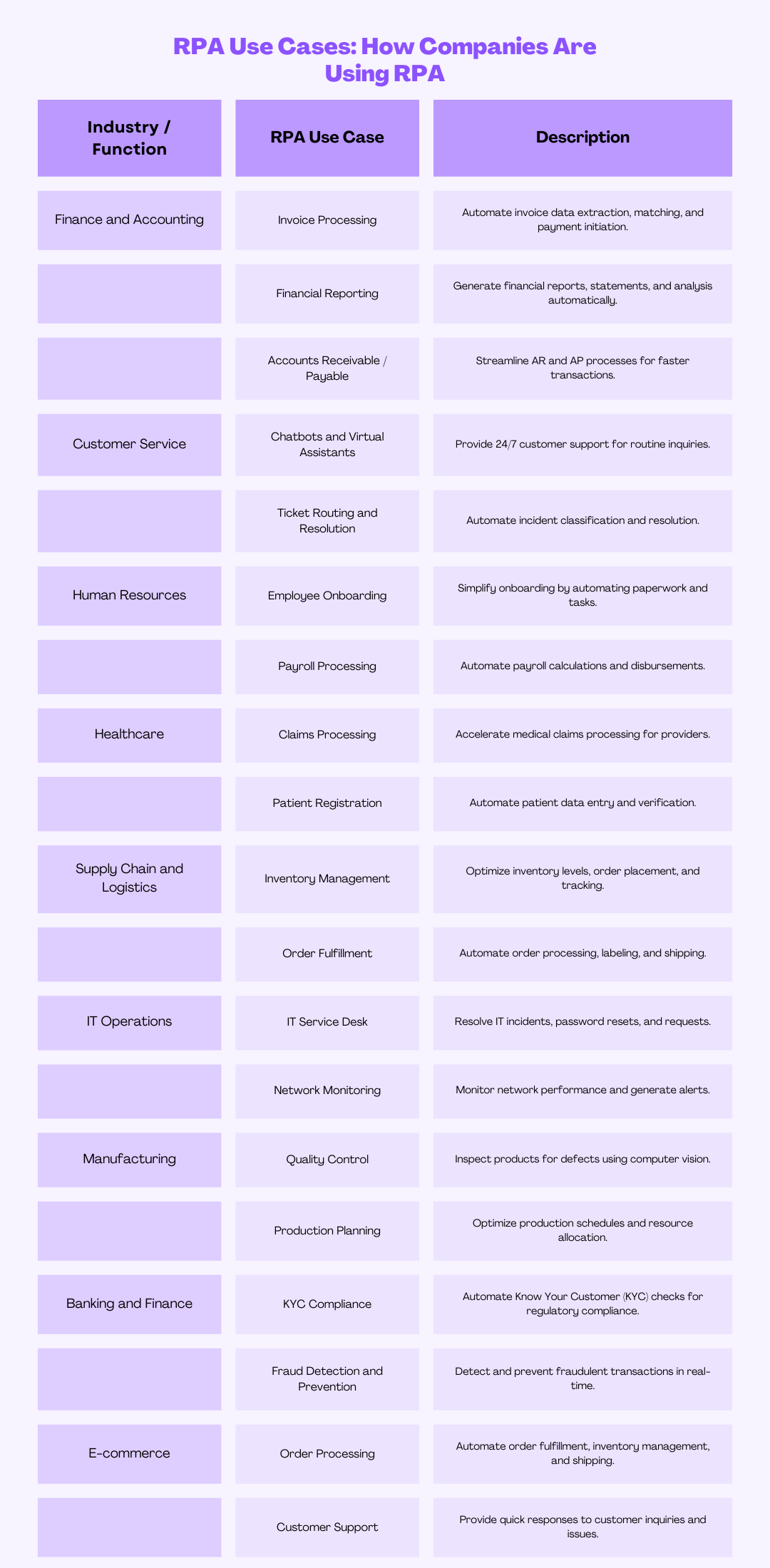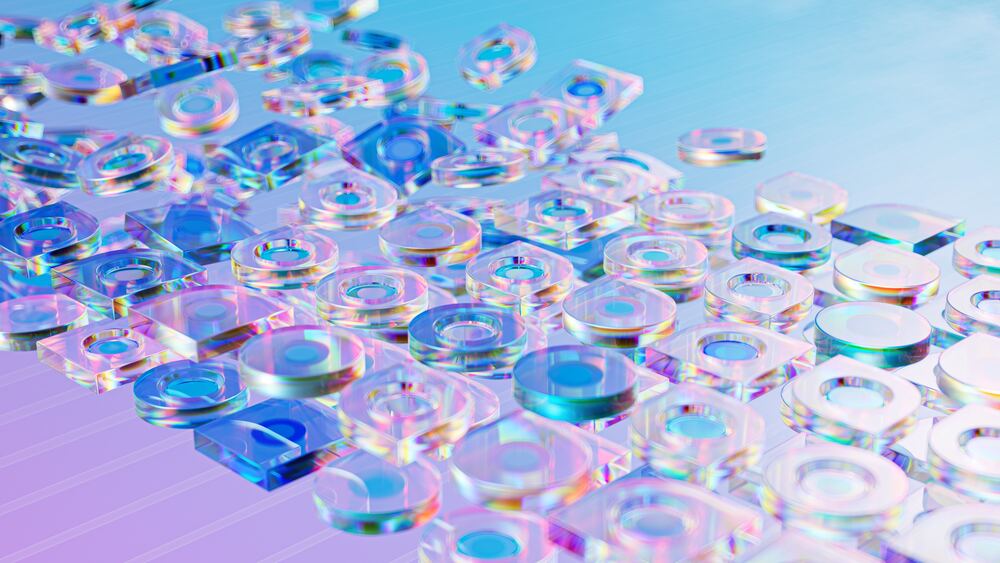Table of Contents:
- What Is RPA? A Definition of Robotic Process Automation
- How RPA Works
- The Benefits of RPA and Why Companies Are Adopting It
- RPA Capabilities: What Can RPA Automate?
- Implementing RPA: Best Practices for Success
- The Future of RPA: What's Next for Intelligent Automation
Introduction
You’ve probably heard the term robotic process automation or RPA thrown around in business circles recently. But what exactly is it and how can it transform your company?
If you’re just getting started with robotic process automation (RPA), you’ve come to the right place! RPA is becoming increasingly popular in the business world - and for good reason!
RPA is using software robots or AI agents to handle high-volume, repetitive tasks that previously required human effort.
It can automate mundane, repetitive tasks, saving time and money while freeing up valuable resources.
In this article, we’ll dive deep into what RPA really means, how it works, the major benefits it offers for businesses, what kinds of tasks RPA is capable of, and how to successfully implement it in your organization.
By the end of this article, you will have a better understanding of robotic process automation and confidence in the steps necessary to use it in your own business.
The future of work is here - are you ready to automate?
What Is RPA? A Definition of Robotic Process Automation
As defined by UiPath, a leading RPA software provider, "Robotic Process Automation is the technology that allows anyone today to configure computer software, or a 'robot' to emulate and integrate the actions of a human interacting within digital systems to execute a business process.”
In simpler terms, RPA is all about training software robots to perform repetitive, mundane tasks that previously required human involvement.
It's a game-changer in the business world as it helps make tedious, manual processes much easier and faster.
What makes RPA so great is that it can integrate with a variety of system platforms without needing access to APIs or any extensive coding knowledge.
How Does RPA Works?
At its core, Robotic Process Automation is the use of software robots or "bots" to mimic and automate human interactions with digital systems and applications.
These bots are not physical robots but rather lines of code designed to perform rule-based, repetitive tasks with precision and accuracy.
RPA bots are programmed to follow a set of predefined rules and steps. They log in to systems, enter data, move files, copy and paste information, fill in forms, and more.
Since the bots mimic human behavior, they can work with legacy systems that don't have APIs.
Let's delve into the inner mechanics of an RPA system.
- Identification of Automation Tasks In the initial stage, processes that can be automated are identified. This typically involves tasks that are repetitive, routine, and rule-based. Examples are data entry, moving files, filling out forms, and reading and sending emails.
- RPA Bot Development This involves the actual development and training of the RPA robots. Depending on the complexity of the task, the robot can be either programmed or 'trained' by capturing the user's actions and then mimicking those actions.
- Implementation and Integration After successful development, the RPA bot is then integrated into the system and begins to execute the tasks assigned to it. These bots can work 24/7, without human intervention.
- Management and Monitoring Finally, the performance of RPA bots is checked regularly and upgraded as required. This helps in ensuring that the bots carry out tasks effectively and efficiently.
The Benefits of RPA and Why Companies Are Adopting It

Robotic Process Automation (RPA) might sound like something out of a sci-fi movie, but it's already being used in industries across the world – from financial services to healthcare.
So why has RPA become so popular?
The answer is simple: RPA offers numerous benefits to companies and consumers alike.
By automating mundane, repetitive tasks, companies are able to streamline their operations and increase efficiency.
This allows them to reduce costs and maximize profits which, in turn, leads to greater customer satisfaction.
Implementing RPA in your business can lead to numerous benefits, including:
- Time savings: RPA can significantly reduce the time required to complete repetitive tasks, freeing up employees to focus on more strategic, value-added activities.
- Reduced errors: RPA performs tasks with a high degree of speed and accuracy. Software robots are not prone to fatigue or distractions, so they produce consistent, high-quality work. This results in fewer errors, higher accuracy, and improved compliance.
- Increased productivity: With RPA handling routine tasks, employees can focus on more important tasks, leading to increased overall productivity. Studies show that RPA can improve productivity by up to 50%.
- Cost savings: RPA can help businesses reduce operational costs by automating labor-intensive tasks and improving process efficiency.
- Scalability: RPA can easily scale to handle fluctuations in workload, enabling businesses to adapt quickly to changing market conditions.
RPA Capabilities: What Can RPA Automate?
RPA software can handle a wide range of repetitive tasks. Some of the major capabilities of RPA include:
Automating Data Entry
RPA is ideal for entering data from one system to another. Whether it's customer records, employee files, or financial transactions, RPA can transfer data quickly and accurately.
This eliminates the manual effort required for repetitive data entry.
Completing Forms
RPA excels at filling out electronic forms. It can populate online forms, PDFs or paper forms with information from various sources.
RPA ensures all required fields are completed correctly and on time. This is useful for applications, surveys, invoices, and more.
Extracting and Compiling Data
RPA can extract specific data from documents like statements, bills, and reports. It can then compile and organize that data as needed.
This is helpful when you need to gather data from multiple sources or in different formats. RPA saves time by automatically collecting and structuring the data.
Generating Reports
RPA can assemble data from various sources and generate reports on a schedule. It ensures reports are consistent, accurate, and delivered on time.
RPA is ideal for reports that draw on multiple data pools or require calculations and metrics. This frees up employees from the routine work of creating and distributing reports.
Processing Transactions
RPA excels at handling high-volume, rules-based transactions. It can process transactions like payments, invoices, insurance claims, payroll, etc.
RPA applies the appropriate rules and procedures automatically to complete transactions accurately and promptly.
This improves transaction cycle times, reduces costs, and enhances the customer experience.

Not only that but RPA can help organizations increase productivity in other areas as well—from improving financial forecasting accuracy to ensuring compliance with government regulations.
So if you're looking for a way to save time and money while increasing efficiency in your organization—robotic process automation might be the perfect solution!
Implementing RPA: Best Practices for Success
Once you’ve decided to implement RPA, it’s important to do it right. Here are some best practices to set your organization up for success:
Start small and scale up
Don’t try to automate every process at once. Identify a few simple, rules-based processes to start with, like data entry or report generation.
Start with a small pilot project to prove the value before expanding. As wins pile up, you can make the case to automate more complex processes.
Focus on high-volume, repetitive tasks
RPA works best for repetitive, high-volume tasks that require lots of manual work but little human judgment.
Processes that take up lots of employees’ time but offer little job satisfaction are great candidates. Look for tasks that are consistent across the organization.
Standardize and optimize processes first
Review the process you want to automate and make sure all steps are standardized and as efficient as possible.
RPA can only automate what people actually do, so you need a consistent process. This upfront work will ensure maximum benefits from automation.
Get buy-in across the organization
From leadership to end users, make sure all stakeholders understand what RPA is, how it will impact them, and the benefits.
Address any concerns upfront through demonstrations and education. When people understand what RPA can and can’t do, they will be more willing to support implementation.
Start with a pilot and build from there
Once you’ve selected an initial process, start with a pilot project to showcase quick wins and help build support.
Choose a small, controlled implementation to work out any issues before large-scale rollouts. Build on your success through incremental expansion into other suitable processes.
Continuously monitor and optimize
Even after initial implementation, continue monitoring KPIs and looking for ways to optimize.
Make incremental improvements to increase efficiency, expand into new use cases, and achieve maximum benefits from your digital workforce.
With ongoing attention, RPA can provide value for years to come.
The Future of RPA: What's Next for Intelligent Automation

Robotic Process Automation (RPA) has become increasingly popular in recent years, and it's no wonder—it’s an intelligent automation technology that helps organizations of all sizes boost productivity and reduce costs.
Looking to the future, we can expect to see even more innovative applications of RPA in the coming years.
AI-Driven Automation
AI-driven automation is quickly becoming a key component of RPA, allowing it to learn from past performance and get better over time.
This means even more accurate outcomes with less manual intervention.
Automation Orchestration
In the future, businesses will be able to orchestrate complex workflows across multiple systems by combining RPA with other powerful digital technologies like machine learning and AI into one seamless automated process.
This will lead to even greater efficiency gains than before.
Smarter Data Management
Integrating RPA with smart data management solutions can enable companies to process data faster and more accurately.
For example, it can help identify any outliers or patterns that may require further investigation or manual review, leading to better decision making and improved insights into operations.
These are just a few of the ways RPA is transforming how businesses operate—and it's only the beginning!
With ever-evolving technologies like AI driving innovation in this space, the possibilities are truly endless.
Conclusion
So there you have it, a complete guide to understanding robotic process automation and how it can transform your business.
RPA isn't some far-off future tech - it's here now and being leveraged by leading companies to cut costs, boost productivity, and improve customer experiences.
Now that you understand what RPA is, how it works, and its major benefits, you're ready to evaluate if it's the right solution for your organization.
The key is starting small with a low-risk pilot program before scaling up.
With the right strategy and implementation, RPA could be the game-changer you've been looking for to optimize critical business processes.
The future of automation is bright - will you be a part of it?








